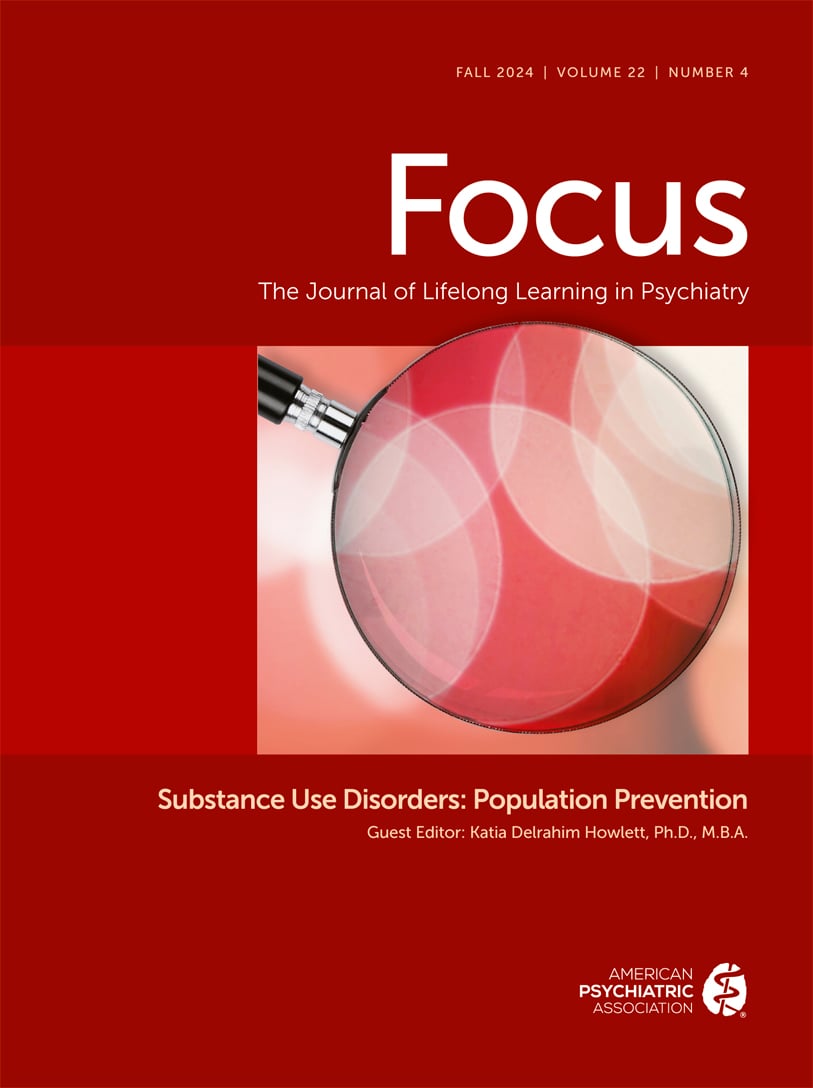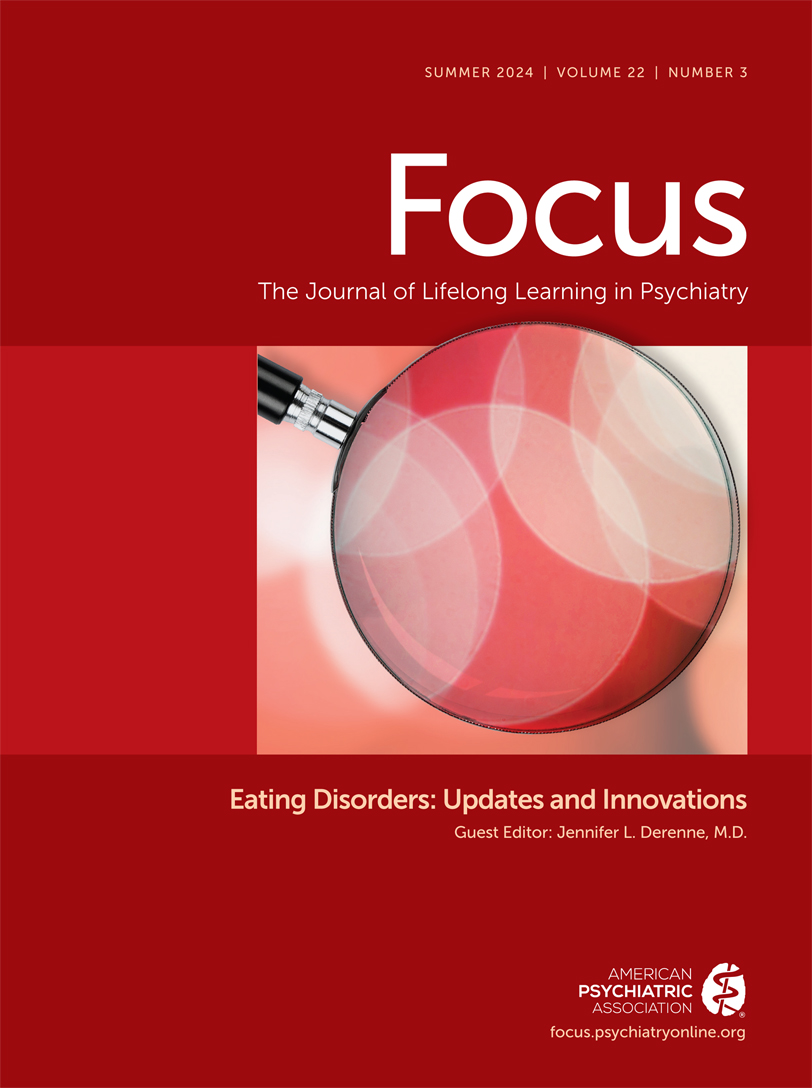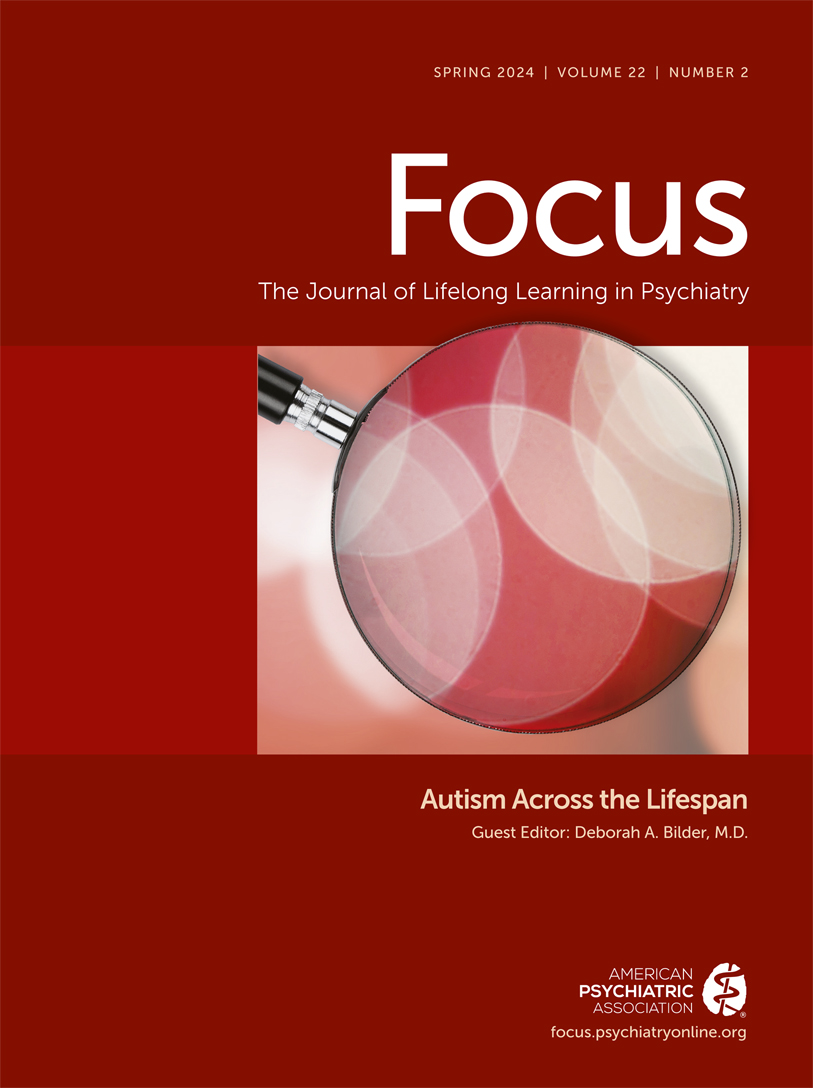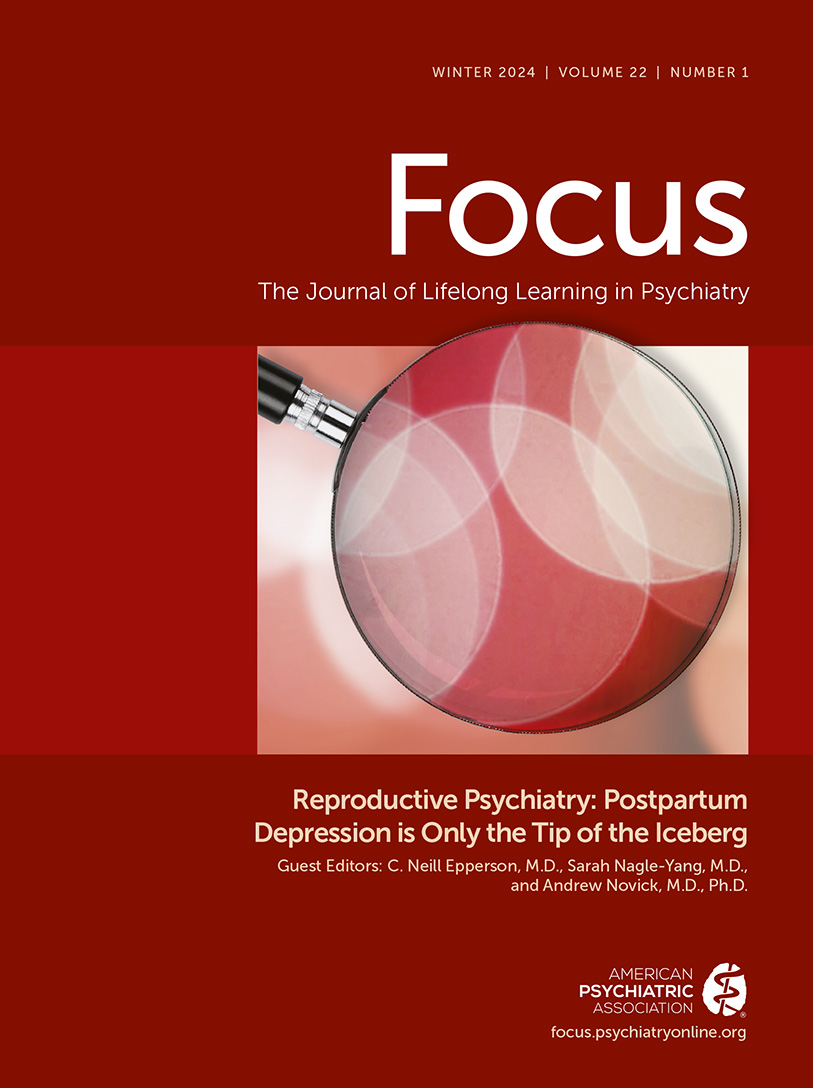Focus
- Volume 3
- Number 1
- January 2005
EDITORIAL
CLINICAL SYNTHESIS
REVIEW
Publication date: 01 January 2005
Pages14–24Major depression is one of the most common psychiatric disorders, with lifetime prevalence rates of over 15%. Recent research provides new insights on which brain regions are affected in the disorder, underlying biological mechanisms, and possible novel ...
https://doi.org/10.1176/foc.3.1.14Publication date: 01 January 2005
Pages27–33This patient management exercise is designed to test your comprehension of material presented in this issue of FOCUS as well as your ability to evaluate, diagnose, and manage clinical problems. Answer the questions below, to the best of your ability, on ...
https://doi.org/10.1176/foc.3.1.27INFLUENTIAL PUBLICATION
Publication date: 01 January 2005
Pages61–68Objective: This study examined the extent to which individuals with a lifetime diagnosis of recurrent unipolar disorder endorse experiencing manic/hypomanic symptoms over their lifetimes and compared their reports with those of patients with bipolar I ...
https://doi.org/10.1176/foc.3.1.61Publication date: 01 January 2005
Pages69–75Objective: The authors investigated the impact of medical comorbidity on the acute phase of antidepressant treatment in subjects with major depressive disorder. Method: A total of 384 outpatients meeting DSM-III-R criteria for major depressive disorder ...
https://doi.org/10.1176/foc.3.1.69Publication date: 01 January 2005
Pages76–82Objective: Studies on the course of major depressive disorder (MDD) among elderly persons are limited to short periods of follow-up, seldom provide comparisons with younger cohorts, and raise other methodological concerns. Methods: Utilizing 15 years of ...
https://doi.org/10.1176/foc.3.1.76Publication date: 01 January 2005
Pages83–97Objective: Major depression is a multifactorial disorder with many etiologic variables that are interrelated through developmental pathways. The authors used structural equation modeling to generate a developmental model for the etiology of major ...
https://doi.org/10.1176/foc.3.1.83Publication date: 01 January 2005
Pages98–105Objective: The authors provide a detailed clinical description of minor depression: its symptoms, level of disability, stability, and relationship to patient and family history of major depressive disorder. Method: Rigorous criteria for minor depression, ...
https://doi.org/10.1176/foc.3.1.98Publication date: 01 January 2005
Pages106–113Objective: This observational study examined the effectiveness of somatic antidepressant treatments as administered in the community. Method: The study group consisted of 285 subjects with an intake diagnosis of major depressive disorder who had entered ...
https://doi.org/10.1176/foc.3.1.106Integrating Psychotherapy and Pharmacotherapy to Improve Outcomes Among Patients With Mood Disorders
Publication date: 01 January 2005
Pages114–121A number of studies have demonstrated comparable benefits of psychosocial interventions and pharmacologic treatments in subgroups of patients with mood disorders. The two treatment modalities are often combined in clinical practice. However, concerns ...
https://doi.org/10.1176/foc.3.1.114Effects of Cognitive Therapy on Psychological Symptoms and Social Functioning in Residual Depression
Publication date: 01 January 2005
Pages122–130Background: About 30% of psychiatric out-patients with major depression demonstrate partial remission. Aims: To explore whether the addition of cognitive therapy (CT) had any differential effect on residual symptoms or social adjustment. Method: Patients ...
https://doi.org/10.1176/foc.3.1.122Publication date: 01 January 2005
Pages131–135Major depressive disorder is associated with considerable morbidity, disability, and risk for suicide. Treatments for depression most commonly include antidepressants, psychotherapy, or the combination. Little is known about predictors of treatment ...
https://doi.org/10.1176/foc.3.1.131Publication date: 01 January 2005
Pages136–139Objective: This study examined the effects of maintenance treatment for late-life depression on social adjustment. The authors hypothesized that elderly patients recovering from depression would have better social adjustment with medication and ...
https://doi.org/10.1176/foc.3.1.136Publication date: 01 January 2005
Pages140–145Depression and hopelessness are risk factors for suicide. The purpose of this study was to examine the extent of suicidal ideation and hopelessness in outpatients with treatment-resistant depression (TRD) and to study the impact of suicidal ideation and ...
https://doi.org/10.1176/foc.3.1.140Publication date: 01 January 2005
Pages146–155Studies have examined hippocampal function and volume in depressed subjects, but none have systematically compared never-treated first-episode patients with those who have had multiple episodes. We sought to compare hippocampal function, as assessed by ...
https://doi.org/10.1176/foc.3.1.146Publication date: 01 January 2005
Pages156–160In a prospective-longitudinal study of a representative birth cohort, we tested why stressful experiences lead to depression in some people but not in others. A functional polymorphism in the promoter region of the serotonin transporter (5-HTT) gene was ...
https://doi.org/10.1176/foc.3.1.156Publication date: 01 January 2005
Pages161–169Objective: To investigate how residual symptoms from an index episode of major depressive disorder may be associated with recurrence, the authors conducted a trial involving four maintenance treatment approaches and examined 1) whether the level and ...
https://doi.org/10.1176/foc.3.1.161Past Issues
View Issues Archive
Vol. 22 | No. 4

Vol. 22 | No. 3

Vol. 22 | No. 2
